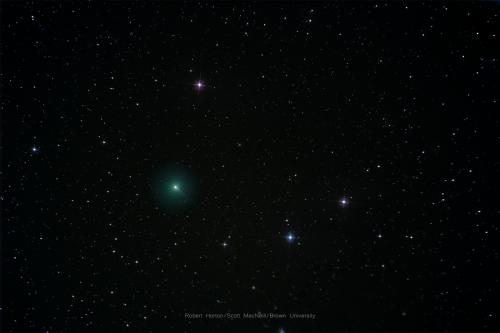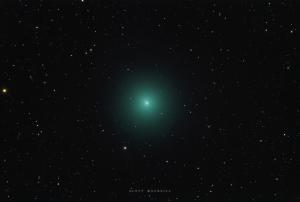Celebration of Space: February 28, 2020
As we continue into year 2020, we have been pretty beat on the comet front. Better stated, we have been pretty beat for the past year on the comet front, with 2020 continuing that trend. We’ve had okay views of Comet C/2019 T2 PanSTARRS, and it’s been exciting since it’s the best comet in the sky at the moment, though overall, it’s not up to par for many of the wintertime comets we have come to observe. Albeit difficult to predict, this may be changing.
A new arrival to the scene, Comet C/2019 Y4, which was discovered on December 28, 2019, just experienced a nice turn of events. In late January, Comet Y4 experienced an outburst, bringing an increase in brightness 100-fold. Outbursts happen when a comet’s nucleus either fractures, breaks up, or regions of volatile material become exposed to the solar wind. These volatile materials will abruptly out-gas into the comet’s coma (a thin atmosphere that forms around the comet), resulting in a dramatic increase in brightness as well as coma radius. If this brightening continues, Comet Y4 could become fabulously bright as it reaches perihelion (closest approach to the Sun).
Comet Y4’s perihelion will happen on May 31, 2020 UTC, with the comet approaching within 0.253 AU of the Sun (23,523,772 miles distant), that’s within the orbit of Mercury. About one week prior, Comet Y4 will make its closest approach to Earth on May 24th at a distance of 72,574,014 miles (roughly 275 times the distance of the Moon). The comet is inclined 45° to the plane of the Solar System, making for good viewing until perihelion nears. Considering perihelion is happening on the other side of the Sun than Earth will be during May, we will eventually be looking towards the Sun and will have to contend with pre-dawn views low on the horizon. Regardless, this comet has many of the same properties as the Great Comet of 1844, and could potentially be part of the same parent object. Though we would consider a repeat of that event wishful thinking. Regardless, this comet has a 2,788 year orbital period, so this is your only chance to see it.
Over the next month, we’ll keep an eye on the comet at Frosty Drew Observatory, and if the comet reaches a brightness that is acceptably visible in backyard telescopes or binoculars, we’ll start posting finder charts regularly to our Facebook and Twitter (@FrostyDrewOBSY) as well as any images we capture. Let’s hope Comet Y4 makes an impressive appearance for us sky watchers this spring!
Tomorrow, February 29, 2020 is a leap-year day, adding an extra day to year 2020. This is a product of the calendar system that we use, the Gregorian calendar. Every year, according to the Gregorian calendar, Earth increases about 0.25 days in its orbit as it relates to the day. Adding an additional day every four years (Feb 29) will make up for this slight increase in orbital position. Otherwise, we would eventually have February happen in the Northern Hemisphere summer. So celebrate the extra day tomorrow with a bit of sunshine, and a night of stargazing. The Seagrave Memorial Observatory in N. Scituate, RI will be open tomorrow night to the public for a quick session of stargazing through their antique 8” Alvin Clark refractor.
Happy Leap Year from all the astro-geeks at Frosty Drew Observatory!
-Scott
- Author:
- Scott MacNeill
- Entry Date:
- Feb 28, 2020
- Published Under:
- Scott MacNeill's Columns




